FASB Proposes Enhancements to Disclosures Related to Disaggregation of Income Statement Expenses (DISE)
Overview
On July 31, 2023, the FASB issued a proposed ASU1 that would enhance disclosures related to DISE for public business
entities (PBEs) to further disaggregate expenses in the footnotes to their
financial statements. However, the face of the income statement would not be
expected to change.
We encourage preparers and practitioners to comment on the
proposed ASU; comments are due by October 30, 2023. In addition, the FASB will
host a public roundtable on December 13, 2023, to discuss the proposal,
including the effective date, which the proposal does not provide. In addition,
the FASB notes on its Web site that “[t]hose
interested in participating in the roundtable should submit a comment letter and
register for consideration.”
Background
There is currently limited guidance in ASC 220-102 on the presentation of expenses in the income statement. The objective of
the proposed ASU is to “address requests from investors for more detailed
information about the types of expenses (including employee compensation,
depreciation, and amortization) in commonly presented expense captions (such as
cost of sales, SG&A [selling, general, and administrative expenses], and
research and development).” The additional disclosure requirements would enable
investors to better understand the entity’s performance, evaluate the entity’s
prospects related to future cash flows, and “[c]ompare an entity’s performance
over time.” Under the proposed ASU, the existing provisions of ASC 205-10 and
ASC 225-10 would be expanded to require PBEs to further disaggregate expenses,
as discussed below.
Main Provisions of the Proposed ASU
The proposed ASU would require PBEs to disclose, in a tabular
format in the footnotes to the financial statements, disaggregated information
about specific categories underlying certain income statement expense line items
that are considered “relevant.” Unless the proposal states otherwise, the
disclosures would be required in both annual and interim financial statements.
Specifically, PBEs would have to disclose:
-
A disaggregation of any relevant expense caption presented on the face of the income statement that contains any of the following expense categories:
-
Depreciation, depletion, and amortization (DD&A) that are recognized as part of oil- and gas-producing activities.
The proposal indicates that a relevant expense caption would be an expense line item included on the face of the income statement that contains any of the expense categories listed in the five sub-bullets above. The application of this guidance may vary from industry to industry; not all income statement line items are expected to be identified as a relevant expense caption.For an illustration of the proposal’s disclosure requirements for entities with service operations, see Example 2 in Appendix A. -
A further disaggregation of inventory and manufacturing expenses (disclosed in accordance with the first sub-bullet above) into the following categories:
-
Purchases of inventory.
-
Employee compensation.
-
Depreciation.
-
Intangible asset amortization.
-
DD&A.
-
Changes in inventories.
-
Other costs capitalized to inventory and manufacturing expenses that are not included in the categories listed in the previous six sub-bullets.
-
Other adjustments and reconciling items.
This further disaggregation is expected to reconcile (1) costs capitalized to inventory during the period and (2) inventory and manufacturing expenses recognized during the period. The purpose is to explain the change in inventory, as presented in the balance sheet, in comparison to the costs recognized during the period. An entity would be required to provide a qualitative explanation for costs included in “other adjustments and reconciling items” as well as for “other costs capitalized to inventory and [other] manufacturing expenses” not included in the above categories. -
-
A qualitative description of the amounts remaining in each relevant expense caption that are not separately disaggregated. The detail of the “qualitative disclosures shall be commensurate with the significance of the amounts being described.”
-
Other expenses, gains, or losses that must be disclosed under existing GAAP, and that are recorded in a relevant expense caption, must be presented in the same tabular disclosure on an annual and, when applicable, interim basis. These amounts are:
-
Specified expenses, gains, and losses that should be presented under existing GAAP for each relevant expense category (e.g., impairment of long-lived assets).
-
Specified expenses, gains, and losses for each relevant expense category, only if those amounts are included entirely in one expense caption and not over multiple expense categories. For example, “if cost of sales was a relevant expense caption . . . and if amortization of costs to fulfill a contract with a customer was recognized entirely in cost of sales and not in multiple expense captions presented on the face of the income statement, then amortization of costs to fulfill a contract with a customer would be required to be included as a separate category.” However, in that same example, if the costs of fulfilling a contract were disaggregated across multiple expense captions, separate disaggregation would not be required.
-
-
A separate total of an entity’s selling expenses, which should be presented in a manner similar to research and development and advertising expenses.
-
The entity’s definitions of other manufacturing expenses and selling expenses. Although the FASB did not define selling expenses, such expenses should include only items that are presented as expenses in the income statement. This disclosure would only be required annually.
Considerations Related to DISE
Inventory and Manufacturing Expense
Inventory expense would include all inventory expenses “resulting from the
derecognition of inventory due to sale to customers, consumption in the
production of goods or services for such sale, or remeasurement (for
example, an impairment)” in accordance with ASC 330 or other
industry-specific guidance. Other manufacturing expenses “generally include,
but are not limited to, certain costs incurred as part of an entity’s
manufacturing activities that are not capitalizable (for example,
unallocated manufacturing overhead related to abnormally low
production).”
Purchases of Inventory
Purchases of inventory would include the amount of costs incurred in the
current reporting period to acquire raw materials and other externally
purchased inputs. These amounts can be capitalized to inventory or
expensed in manufacturing activities.
Changes in Inventories
A change in inventories would be calculated as the difference “between
the amount of inventory included on the balance sheet presented at the
end of the prior period and the amount of inventory included on the
balance sheet presented at the end of the current period.”
Connecting the Dots
Paragraph BC49 of the proposed ASU’s Background Information and
Basis for Conclusions states that “changes in inventories . . .
could include an adjustment to inventories resulting from an
impairment charge related to inventories capitalized in a prior
period.” Because the change in inventory presented on the
balance sheet year over year incorporates this adjustment, this
specific cost category reflects changes to the balance sheet
that would not otherwise be included in the expense categories
listed in the proposed ASU.
Other Adjustments and Reconciling Items and Other Costs Capitalized to Inventory and Other Manufacturing Expenses
Other adjustments and
reconciling items would include, if not disclosed separately, “other
amounts that are necessary to reconcile costs incurred to expenses
recognized.” As noted in the proposed ASU, these other adjustments would
include, if applicable:
-
“The amount of inventory derecognized during the period that does not meet the definition of inventory expense (for example, inventory derecognized as part of derecognition transactions within the scope of Subtopic 810-10 on consolidation).”
-
“The amount attributable to differences in the foreign currency exchange rates used to translate costs incurred, the beginning balance of inventory, and the ending balance of inventory in accordance with Subtopic 830-30 on foreign currency matters.”
For an illustration of the proposal’s disclosure
requirements for entities that have inventory and manufacturing
expenses, see Example
1 in Appendix A.
Employee Compensation
The definition of an
employee in the proposed ASU is aligned with that in ASC 718. Employee
compensation is intended to broadly capture the major types of consideration
granted or issued to employees in exchange for services. Disclosures about
employee compensation should include separate presentation of one-time
employee termination benefits, when applicable, within the tabular
disclosure.
An entity can elect to include in employee compensation “amounts attributable
to other transactions entered into for the benefit of employees (for
example, the provision of subsidized goods or services).” Such an election
would be applied consistently, and an entity should “disclose both that
those transactions have been included and a description of those
transactions.”
Connecting the Dots
The proposed ASU includes a practical expedient for
entities that present an expense caption for salaries and employee
benefits on the face of the income statement in compliance with SEC
Regulation S-X, Rule 9-04.3 This expedient, if elected, allows entities to continue using
a classification meeting that requirement, as opposed to
disaggregating employee compensation in accordance with the proposed
ASU.
For an illustration of the proposal’s disclosure
requirements for banks and bank holding entities, see Example 3 in Appendix
A.
Depreciation
Depreciation would be consistent with the amounts recorded
in accordance with ASC 360-10.
Intangible Asset Amortization
Intangible asset
amortization would be consistent with the amounts recorded in accordance
with ASC 350-30.
Amortization of a finance lease right-of-use asset and
amortization of leasehold improvements that are recorded under ASC 842-20
would be included in either depreciation or intangible asset amortization
expense categories.
Depreciation, Depletion, and Amortization
Although the Board acknowledges that DD&A is an industry-specific
expense, paragraph BC44 of the proposed ASU explains that “DD&A was
included as a separate required category because it represents a potentially
significant noncash expense that is recognized systematically, like
depreciation and intangible asset amortization.”
Thinking Ahead
The FASB is releasing the proposed ASU in response to the
continuing push from investors to obtain more information about an entity’s
financial performance, particularly the expenses an entity incurs in a given
period (e.g., to better understand an entity’s performance, assess an entity’s
future cash flows, and evaluate an entity’s performance over time and compare it
with that of other entities). We believe that an entity may need to modify its
existing financial reporting systems to compile and present the information
required under the proposed amendments.
As stated in paragraph BC121(f) of the proposed ASU, the Board chose not to
provide prescriptive guidance on how an entity classifies certain expenses. As a
result, entities may present certain expense amounts differently and there may
be a lack of comparability among entities, even those in similar industries.
Given the potential need to modify existing financial reporting
systems and the possibility of creating classification diversity given the lack
of prescriptive guidance on this topic, we encourage preparers and practitioners
to provide the FASB with feedback on the proposed amendments. See Appendix B for a list of the
proposed ASU’s specific questions for respondents.
Proposed Effective Date and Transition
Effective Date
The Board will determine the effective date of the guidance, and whether to
permit early adoption, after considering feedback on the proposed
amendments.
Transition
PBEs would be required to adopt the new guidance prospectively; however, an
optional retrospective application would also be provided.
Appendix A — Illustrative Examples
The examples below have been reproduced from the proposed ASU.
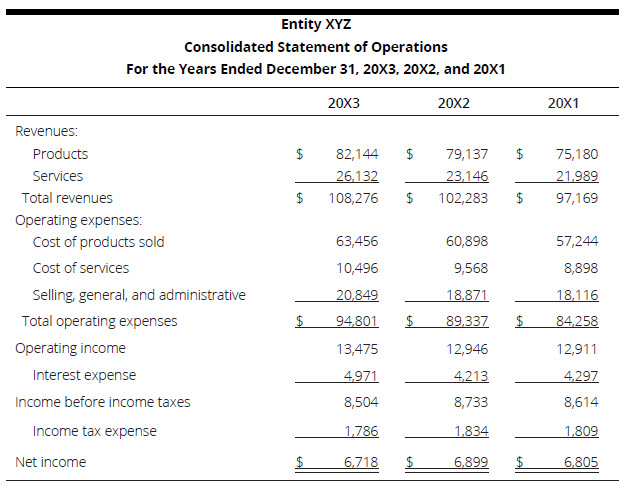
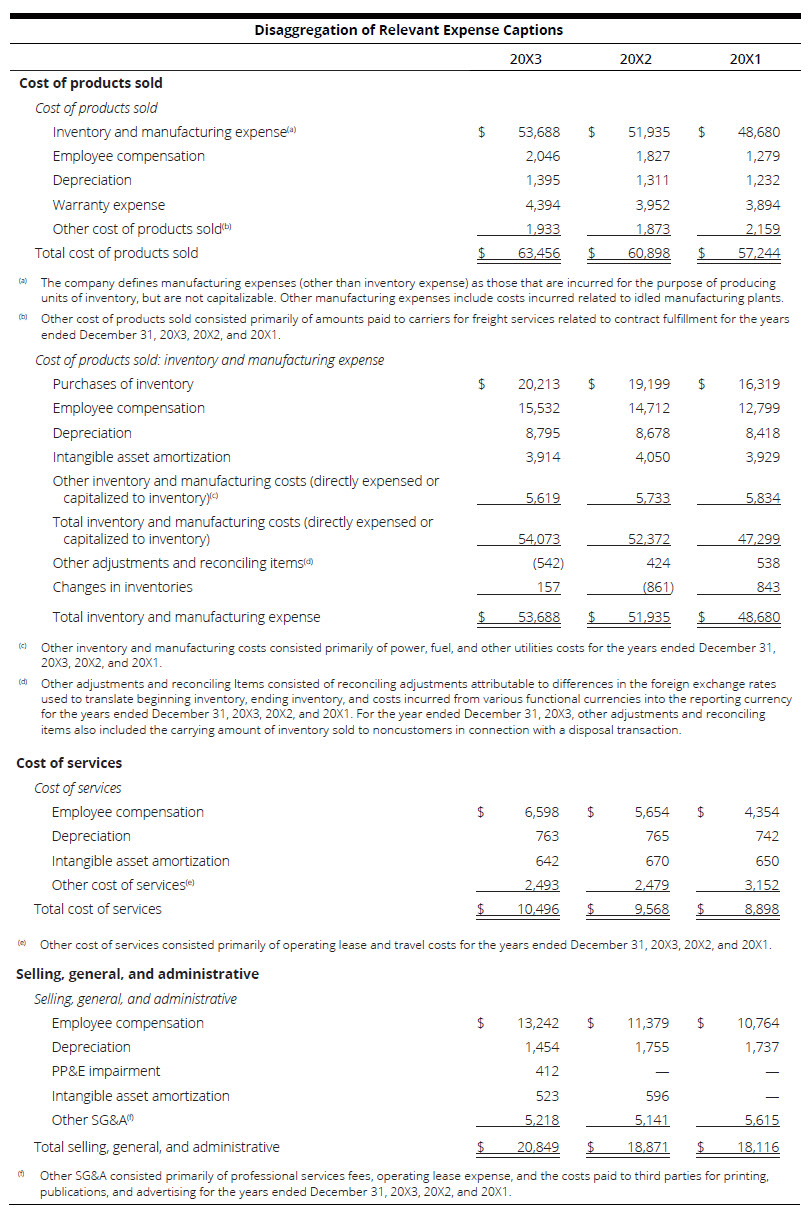
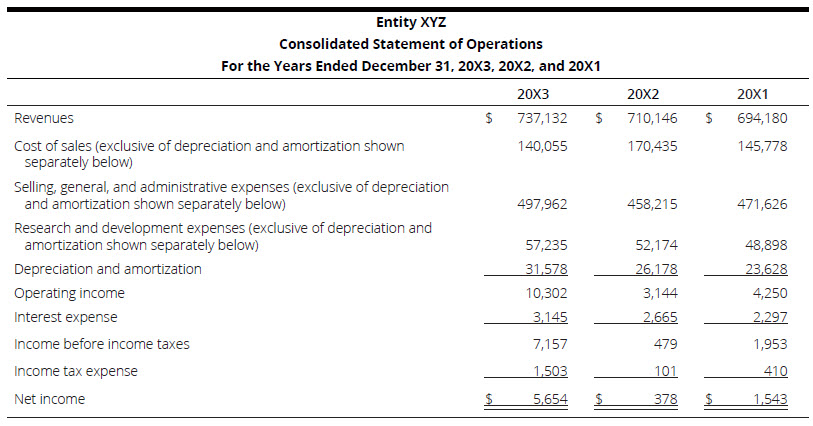
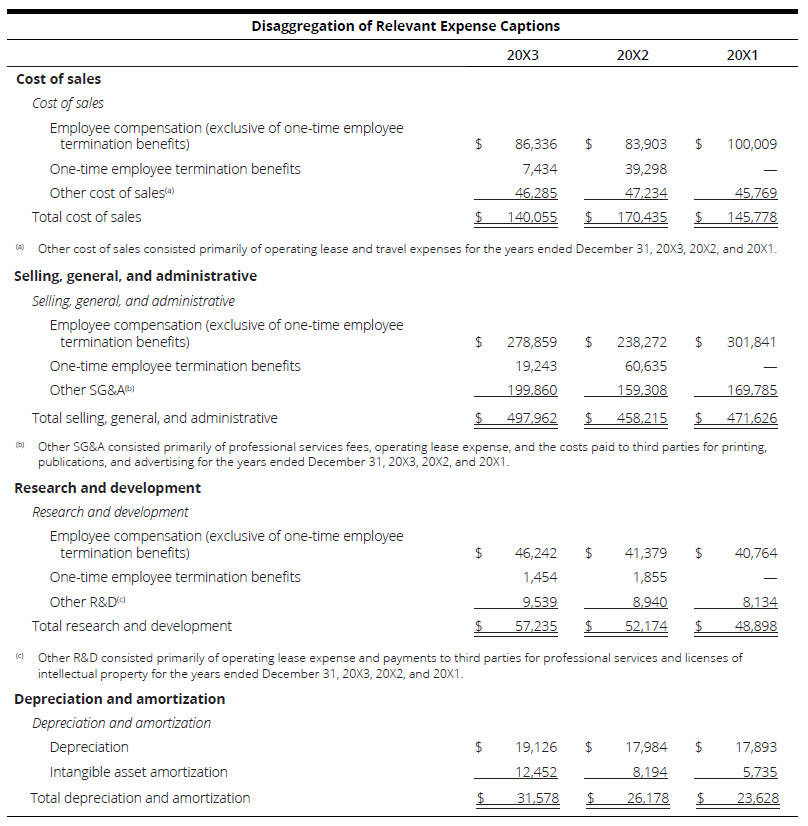
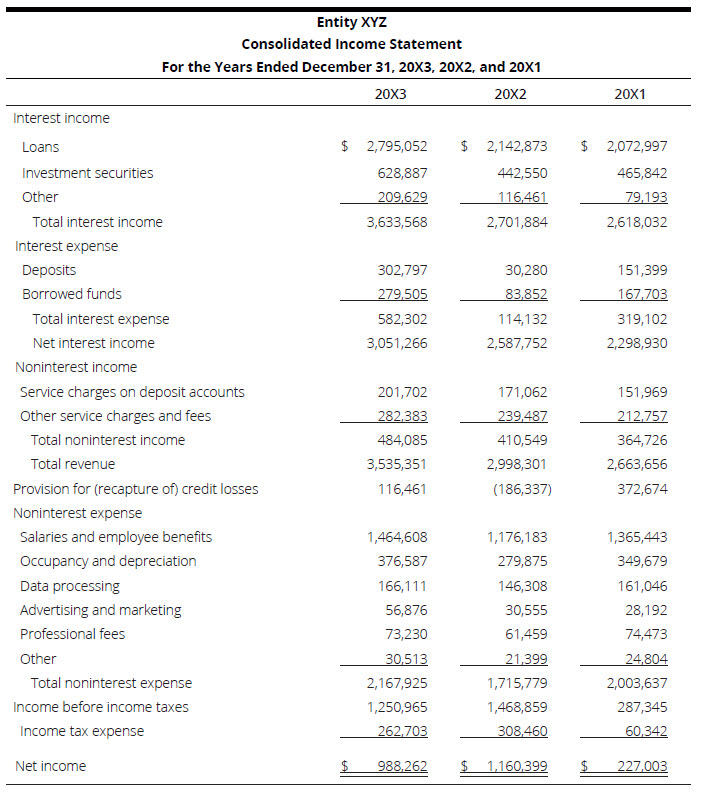
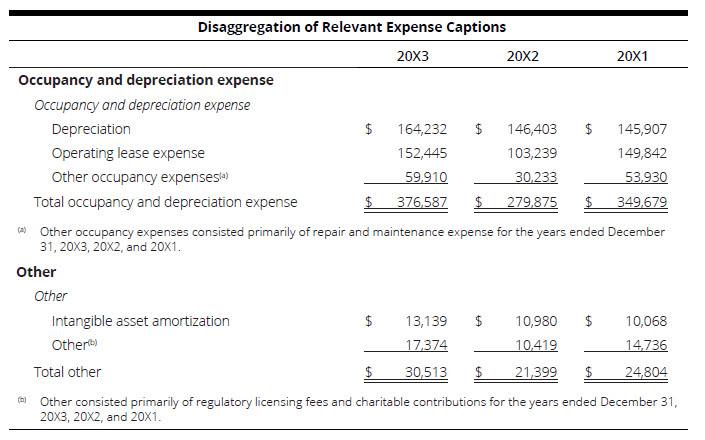
ASC 220-40
Example 1:
Disaggregation of Income Statement Expenses by an
Entity With Manufacturing and Service
Operations
55-4 This
Example illustrates one type of tabular format
disclosure that an entity could use to disclose
disaggregated expense amounts in accordance with
paragraphs 220-40-50-1 through 50-21. This Example also
illustrates the disclosure of selling expenses in
accordance with paragraphs 220-40-50-22 through
50-23.
55-5 For the
year ended December 31, 20X3, Entity XYZ, which is a
manufacturer with significant service operations,
presents the following comparative statement of
operations.
55-6 Entity XYZ
provides a disclosure that disaggregates the cost of
products sold, cost of services, and selling, general,
and administrative expense captions into the categories
listed in paragraph 220-40-50-4. Those expense captions
were identified as relevant expense captions because
those captions contain one or more of the expense
categories listed in paragraph 220-40-50-4. Even though
Entity XYZ presents other expense captions on the face
of its consolidated statement of operations, such as
interest expense and income tax expense, those expense
captions do not contain any of the expense categories
listed in paragraph 220-40-50-4 (including those
described in paragraph 220-40- 50-9), so those expense
captions do not need to be disaggregated.
55-7 In addition
to the categories listed in paragraph 220-40-50-4,
Entity XYZ further disaggregates inventory and
manufacturing expense in accordance with the
requirements in paragraphs 220-40-50-17 through 50-21.
In accordance with paragraph 220-40-50-21, Entity XYZ
qualitatively describes the nature of amounts included
in other costs capitalized to inventory and other
manufacturing expenses and other adjustments and
reconciling items.
55-8 Entity XYZ
also recognizes impairment of property, plant, and
equipment classified as held and used in selling,
general, and administrative expenses and, therefore,
includes this impairment as a separate category in the
tabular format disclosure in accordance with paragraph
220-40-50-12.
55-9 Entity XYZ
recognizes expenses associated with warranty accruals
entirely within cost of products sold and, therefore,
includes warranty expense as a separate category in
accordance with paragraph 220-40-50-13.
55-10 Entity XYZ
recognizes operating lease cost in both cost of services
and selling, general, and administrative expenses.
Therefore, in accordance with paragraph 220-40-50-13,
Entity XYZ is not required to separately disclose the
amounts of cost of services and selling, general, and
administrative expenses that are attributable to
operating lease cost. Instead, those expenses are
included in the amount for other items for each relevant
expense caption in accordance with paragraph
220-40-50-16.
55-11 Entity XYZ
provides the following disclosure.
55-12 In
addition to the tabular format disclosure illustrated in
paragraph 220-40-55-11, Entity XYZ also must disclose
its selling expenses and how it defines selling expenses
in accordance with paragraphs 220-40-50-22 through
50-23.
Selling
Expenses
During the years
ended December 31, 20X3, 20X2, and 20X1, selling
expenses were $13,425, $12,123, and $11,585,
respectively. The entity’s selling expenses include
those expenses related to marketing and promotional
activities and client relationship management.
Example 2:
Disaggregation of Income Statement Expenses by an
Entity With Service Operations
55-13 This
Example illustrates one type of tabular format
disclosure that an entity could use to disclose
disaggregated expense amounts in accordance with
paragraphs 220-40-50-1 through 50-16. This Example also
illustrates the disclosure of selling expenses in
accordance with paragraphs 220-40-50-22 through
50-23.
55-14 For the
year ended December 31, 20X3, Entity XYZ, which is a
services provider, presents the following comparative
statement of operations.
55-15 Entity XYZ
provides a disclosure that disaggregates the cost of
sales; selling, general, and administrative expenses;
research and development expenses; and depreciation and
amortization captions into the categories listed in
paragraph 220-40-50-4. Those expense captions were
identified as relevant expense captions because those
captions contain one or more of the expense categories
listed in paragraph 220-40-50-4. Even though Entity XYZ
presents other expense captions on the face of its
consolidated statement of operations, such as interest
expense and income tax expense, those expense captions
do not contain any of the expense categories listed in
paragraph 220-40-50-4 (including those described in
paragraph 220-40-50-9), so those expense captions do not
need to be disaggregated.
55-16 Entity XYZ
also recognizes one-time employee termination benefits
in cost of sales; selling, general, and administrative
expenses; and research and development expenses and,
therefore, includes this amount as a separate category
in the tabular format disclosure in accordance with
paragraph 220-40-50-12. Paragraph 220-40-50-12(e)
requires that an entity disclose the amount of each
major type of cost associated with an exit or disposal
activity (for example, one-time employee termination
benefits) that is recognized in each relevant expense
caption in the same tabular format in which the
disclosures required by paragraph 220-40-50-4 are
provided. Because one-time employee termination benefits
are a form of employee compensation, Entity XYZ
discloses that its employee compensation category
excludes one-time employee termination benefits because
one-time employee termination benefits are disclosed as
a separate category.
55-17 Entity XYZ
recognizes operating lease cost in both cost of sales
and selling, general, and administrative expenses.
Therefore, in accordance with paragraph 220-40-50-13,
Entity XYZ is not required to separately disclose the
amounts of cost of sales and selling, general, and
administrative expenses that are attributable to
operating lease cost. Instead, those expenses are
included in the amount for other items for each relevant
expense caption in accordance with paragraph
220-40-50-16.
55-18 Entity XYZ
provides the following disclosure.
55-19 In
addition to the tabular format disclosure illustrated in
paragraph 220-40-55-18, Entity XYZ also must disclose
its selling expenses and how it defines selling expenses
in accordance with paragraphs 220-40-50-22 through
50-23.
Selling
Expenses
During the years
ended December 31, 20X3, 20X2, and 20X1, selling
expenses were $224,536, $223,493, and $231,892,
respectively. The entity’s selling expenses include
those expenses related to advertising and certain
customer acquisition-related costs.
Example 3:
Disaggregation of Income Statement Expenses by a
Bank
55-20 This
Example illustrates one type of tabular format
disclosure that an entity could use to disclose
disaggregated expense amounts in accordance with
paragraphs 220-40-50-1 through 50-16. This Example also
illustrates the disclosure of selling expenses in
accordance with paragraphs 220-40-50-22 through
50-23.
55-21 For the
year ended December 31, 20X3, Entity XYZ, which is a
bank, presents the following comparative income
statement.
55-22 Entity XYZ
provides a disclosure that disaggregates the occupancy
and depreciation expense and other expense captions into
the categories listed in paragraph 220-40-50-4. Those
expense captions were identified as relevant expense
captions because those captions contain one or more of
the expense categories listed in paragraph 220-40-50-4.
In this Example, even though Entity XYZ also presents
separate expense captions on the face of its
consolidated income statement for interest expense,
provision for credit losses, data processing,
advertising and marketing, professional fees, and income
tax expense, those expense captions do not contain any
of the expense categories listed in paragraph
220-40-50-4 (including those described in paragraph
220-40-50-9); therefore, those expense captions do not
need to be further disaggregated. Entity XYZ applies the
practical expedient for employee compensation described
in paragraph 220-40-50-11 and elects to not repeat the
amount presented on the face of the income statement in
the notes to financial statements.
55-23 Entity XYZ
recognizes operating lease cost entirely within
occupancy and depreciation expense and, therefore,
includes operating lease cost as a separate category in
accordance with paragraph 220-40-50-13.
55-24 Entity XYZ
provides the following disclosure.
55-25 In
addition to the tabular format disclosure illustrated in
paragraph 220-40-55-24, Entity XYZ also must disclose
its selling expenses and how it defines selling expenses
in accordance with paragraphs 220-40-50-22 through
50-23.
Selling
Expenses
During the years
ended December 31, 20X3, 20X2, and 20X1, the company
defined selling expenses to be the same as its
advertising and marketing expenses, which are presented
on the face of its consolidated income statement. The
entity’s advertising and marketing expenses include
costs incurred for advertising, market research, and
business development.
Appendix B — Questions for Respondents
The proposed ASU includes the
following questions (reproduced from the proposal) for respondents to consider:
Expense Captions Subject to Disaggregation Requirements
Question 1: The amendments in this proposed Update would require that
a public business entity disclose disaggregated relevant expense
captions in the notes to financial statements. For preparers and
practitioners, are the proposed amendments for identifying relevant expense
captions operable? Please explain why or why not. If not, what changes would
you make?
Entities in Scope
Question 2: Should the proposed amendments apply to all public
business entities? Please explain why or why not.
Required Expense Categories
Question 3: The proposed amendments would require that an entity
disclose the amounts of (a) inventory and manufacturing expense, (b)
employee compensation, (c) depreciation, (d) intangible asset amortization,
and (e) DD&A that are included in each relevant expense caption. For
investors, would this proposed disclosure provide decision-useful
information? If so, how would that information be used? If not, what changes
would you make? Would any of the proposed categories not provide
decision-useful information? For example, are there categories that would be
more decision useful than the ones being proposed?
Question 4: For preparers, how does requiring disclosure of certain
categories of expenses included in relevant expense captions compare with
the operability and cost of requiring full disaggregation of income
statement expenses into natural categories (including the disclosure of
additional categories that would not be required by the proposed
amendments)? Are there other broadly applicable expense categories or
disaggregation approaches that would provide investors with more
decision-useful information, be less costly to provide, or both? Please
explain why or why not.
Question 5: For preparers and practitioners, is the proposed
definition of inventory expense operable? Please explain why or why
not. If not, what changes would you make?
Question 6: The proposed amendments would leverage the existing
definition of employee in Topic 718, Compensation — Stock
Compensation, and would add a definition of employee compensation.
For preparers and practitioners, are the proposed definitions of
employee and employee compensation operable, including for
entities with international operations, and would the proposed amendments
affect entities’ current application of the definition of employee in
Topic 718? Please explain. What changes, if any, would you make? For
preparers, would the proposed practical expedient that would allow certain
entities to disclose salaries and benefits in accordance with SEC Regulation
S-X Rule 9-04 be less costly to apply than applying the proposed definition
of employee compensation? For investors, would permitting the
application of that proposed practical expedient affect the decision
usefulness of the proposed disclosures? For all stakeholders, should the
definition of employee compensation include additional costs or
exclude any of the costs proposed? Please explain why or why not.
Question 7: For preparers and practitioners, would linking
depreciation and intangible asset amortization to existing disclosure
requirements in Subtopic 360-10, Property, Plant, and Equipment — Overall,
and Subtopic 350-30, Intangibles — Goodwill and Other — General Intangibles
Other Than Goodwill, be operable? Please explain why or why not.
Further Disaggregation of Inventory and Manufacturing Expense
Question 8: The proposed amendments would require further
disaggregation of inventory and manufacturing expense into the following
categories of costs incurred: (a) purchases of inventory, (b) employee
compensation, (c) depreciation, (d) intangible asset amortization, and (e)
DD&A. Those costs incurred categories would include costs that flow into
the balance sheet as inventory and also would include manufacturing costs
that are expensed directly. The costs incurred categories would not
represent costs flowing from inventory on the balance sheet to the income
statement when that inventory is sold or impaired. Residual costs incurred
would be included in an “other” category. For investors, would this proposed
disclosure provide decision-useful information? If so, how would that
information be used? If not, what changes would you make? Would any of the
proposed costs incurred categories not provide decision-useful information?
For example, are there categories that would be more decision useful than
the ones being proposed? Should the proposed requirement to further
disaggregate costs incurred that flow into the balance sheet as inventory be
expanded to include assets other than inventory? If so, which assets?
Question 9: The proposed amendments would require (a) that the costs
incurred that were capitalized to inventory during the current period be
combined with other manufacturing expenses and (b) that this total of
manufacturing-related expenses be disaggregated and disclosed separately
from nonmanufacturing expenses. For preparers, would this proposed
requirement be more or less costly to implement than if all such costs
(manufacturing and nonmanufacturing) were permitted to be combined? For
preparers and practitioners, is this proposed requirement operable? Please
explain why or why not.
Question 10: For preparers and practitioners, is the proposed
requirement to classify certain expenses as part of manufacturing activities
and disclose how an entity defines other manufacturing expenses (other
manufacturing expenses together with inventory expense constitute inventory
and manufacturing expenses) operable? Please explain why or why not. If not,
what changes would you make?
Question 11: For preparers and practitioners, are there any potential
practical expedients that would simplify or reduce the costs associated with
disaggregating inventory and manufacturing expense but would not
significantly diminish the decision usefulness of the information provided
to investors? For any potential practical expedients suggested, please
explain your reasoning.
Integration of Existing Disclosure Requirements
Question 12: The proposed amendments would require that an entity
include certain existing disclosures of expenses in the same tabular format
disclosure as the disclosures that would be required by the proposed
amendments. For investors, would including those expenses in the same
tabular format disclosure provide decision-useful information? Would this
improve your ability to locate relevant expense information in the notes to
financial statements? Please explain why or why not. For preparers and
practitioners, is this proposed requirement operable? Please explain why or
why not. For all stakeholders, are there other existing disclosures that are
not reflected in the proposed amendments and should be included in the lists
in paragraph 220-40-50-12, paragraph 220-40-50-13, or both? Please explain
why or why not.
Question 13: In addition to the disclosure requirements being
proposed, should other expenses that are currently disclosed in the
financial statements also be required to be integrated into the tabular
format disclosures (for example, other expenses that an entity voluntarily
discloses in total in the notes to financial statements)? Please explain why
or why not.
Qualitative Description of Other Items
Question 14: The proposed amendments would require that an entity
provide a qualitative description of any other items remaining in relevant
expense captions and any costs remaining in inventory and manufacturing
expense after the specific disaggregation requirements are applied. For
investors, would this proposed requirement provide decision-useful
information? If so, how would that information be used? If not, what changes
would you make? For preparers and practitioners, is this proposed
requirement operable? Please explain why or why not.
Selling Expenses
Question 15: The proposed amendments would require that an entity
disclose selling expenses and how it defines selling expenses. Should a
definition of selling expenses be developed, or should an entity be
required to determine what constitutes a selling expense? For investors,
would the proposed requirement provide decision-useful information? If so,
how would that information be used? If not, what changes would you make? For
preparers and practitioners, is the proposed requirement operable? Please
explain why or why not.
Interim Reporting
Question 16: The proposed amendments would require the disclosures on
both an annual basis and an interim basis. Do you agree with those proposed
amendments? Please explain why or why not.
Transition and Effective Date
Question 17: The proposed amendments would be applied on a prospective
basis with an option for an entity to apply the guidance retrospectively. Is
that proposed transition method operable? If not, why not and what
transition method would be more appropriate and why? Would the information
disclosed under the proposed transition method be decision useful? Please
explain why or why not.
Question 18: For preparers, would you expect to apply the proposed
amendments retrospectively, even if not required, to assist investors in
comparing performance to previous periods? Please explain why or why
not.
Question 19: Regarding the effective date, how much time would be
needed to implement the proposed amendments? Should early adoption be
permitted? Please explain why or why not.
Contacts
|
|
Tony Goncalves
Audit &
Assurance
Managing
Director
Deloitte &
Touche LLP
+1 202 879
4910
|
|
Kathleen Malone
Audit &
Assurance
Managing
Director
Deloitte &
Touche LLP
+1 203 761
3770
|
|
|
Christina Benvenuti
Audit &
Assurance
Senior Manager
Deloitte &
Touche LLP
+1 469 417
2349
|
Footnotes
1
FASB Proposed Accounting Standards Update (ASU),
Income Statement — Reporting Comprehensive Income — Expense
Disaggregation Disclosures (Subtopic 220-40): Disaggregation of
Income Statement Expenses.
2
For titles of FASB Accounting Standards
Codification (ASC) references, see Deloitte’s “Titles of Topics and
Subtopics in the FASB Accounting Standards
Codification.”
3
SEC Regulation S-X, Rule 9-04, Statements
of Comprehensive Income.